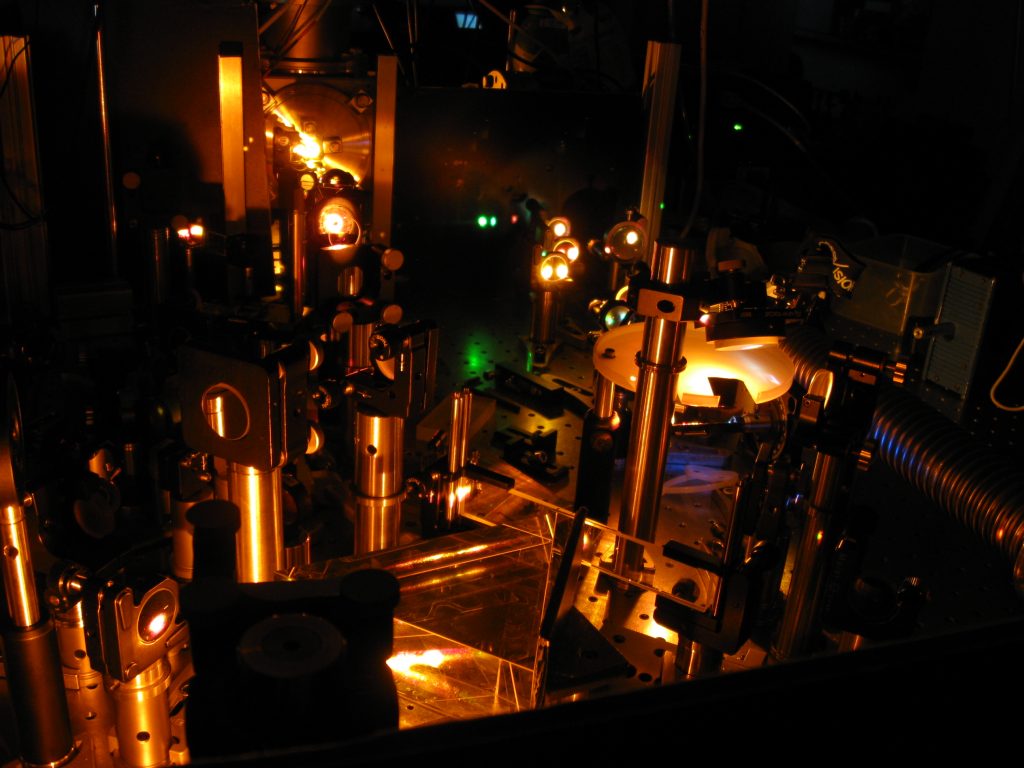13.10.2021 Regelungsstrategien für hoch-energetische gepulste Laserquellen
Projektschwerpunkte
- Mathematische Modellierung und Analyse auftretender Dynamiken im Laser
- Entwicklung modellbasierter adaptiver Pulsformungsalgorithmen
- Unterdrückung dynamischer Instabilitäten und stochastischer Fluktuationen durch Regelungsmethoden
- Ausloten des Potentials von integriertem Hardware/Software Codesigns für gepulste Laserquellen
Beschreibung
Kurze hochenergetische Laserpulse sind zu einem wertvollen und flexiblen Werkzeug mit Anwendungen von physikalischer und chemischer Grundlagenforschung (beispielsweise in der Hochenergiephysik, zum Pumpen optisch-parametrischer Verstärker und Freie-Elektronen-Laser, zur kohärenten Stimulation von atomarer und molekularer Prozesse) bis hin zur ablationsbasierten Materialbearbeitung und Augenchirurgie geworden. Die Erzeugung besonders kurzer Laserpulse geschieht dabei durch Injektion eines Quellpulses eines Oszillators (z.B. eines Mode-Locked-Lasers) in einen Resonator mit gepumptem Lasermedium – ein sogenanntes Master Oscillator Power Amplifier (MOPA) Konzept. Genügen auch etwas längere Pulsdauern, wird typischerweise gänzlich auf Quellpulse verzichtet und der Aufbau von optischer Energie im Resonator wird durch stochastische Zerfallsprozesse zufolge spontaner Emission selbsttätig angetrieben – wie in klassischen gütegeschalteten Lasern.
Viele zukunftsträchtige Anwendungsgebiete von gepulstem Laserlicht bedingen einen Betrieb der Laserquellen in zunehmend extremen und herausfordernden Betriebszuständen mit spezifischen Herausforderungen. Beispielsweise profitieren Oberflächenuntersuchungen und spektroskopische Anwendungen von hohen Pulswiederholraten, welche nahe oder innerhalb des instabilen Betriebsbereichs von gepumpten Resonatoren liegen. Dies ist besonders relevant wenn mehrstufige Verstärkerkaskaden auf Platz- und Kostengründen für die intendierte Anwendung nicht sinnvoll sind. Zusätzlich verhindern starke stochastische Energiefluktuationen zufolge spontaner Emission in gütegeschalteten Resonatoren den Einsatz in Messanwendungen. Die benötigten Bandbreiten für ultra-kurze Laserpulse deformieren den Laserpuls zudem stark, was zu zeitlich starken verbreiteten Ausgangspulsen führt.
Die notwendige Steuerungshardware in modernen Pulsquellen basiert weitgehend auf elektronisch programmierbaren optischen Aktuatoren wie beispielsweise akusto-optischen Modulatoren (AOMs) oder sog. spatial light modulators (SLMs). Dies legt die Verwendung regelungstechnischer Methoden nahe, um obige Effekte zu vermindern oder vollständig zu eliminieren. Insbesondere ermöglicht die systematische Einbeziehung von Regelungskonzepten während des optischen Laserdesigns die Entwicklung effizienterer, ökonomischerer und flexiblerer Lasersysteme.
Ausgewählte Publikationen
- A. Deutschmann-Olek, K. Schrom, and A. Kugi, Control of the formation and amplification of pulse bursts in regenerative amplifiers, IET Control Theory & Applications, vol. 17, iss. 4, p. 419–432, 2023.
[BibTex] [Download]@Article{DeutschmannOlek2023, author = {Deutschmann-Olek, Andreas and Schrom, Katharina and Kugi, Andreas}, title = {Control of the formation and amplification of pulse bursts in regenerative amplifiers}, doi = {10.1049/cth2.12378}, number = {4}, pages = {419--432}, volume = {17}, journal = {IET Control Theory \& Applications}, year = {2023}, } - L. Tarra, A. Deutschmann-Olek, and A. Kugi, Nonlinear feedback stabilisation and stochastic disturbance suppression of actively Q-switched lasers, in Proceedings of the 22nd IFAC World Congress, Yokohama, Japan, 2023 2023, pp. 77-82.
[BibTex]@InProceedings{Tarra2023, author = {Tarra, L. and Deutschmann-Olek, A. and Kugi, A.}, booktitle = {Proceedings of the 22nd IFAC World Congress}, date = {2023}, title = {Nonlinear feedback stabilisation and stochastic disturbance suppression of actively Q-switched lasers}, doi = {10.1016/j.ifacol.2023.10.1550}, number = {2}, pages = {77-82}, volume = {56}, address = {Yokohama, Japan}, issue = {2}, journaltitle = {IFAC-PapersOnLine}, month = {7}, year = {2023}, } - L. Tarra, A. Deutschmann-Olek, V. Stummer, T. Flöry, A. Baltuska, and A. Kugi, Stochastic nonlinear model of the dynamics of actively Q-switched lasers, Optics Express, vol. 30, iss. 18, p. 32411–32427, 2022.
[BibTex]@Article{Tarra2022, author = {Lukas Tarra and Andreas Deutschmann-Olek and Vinzenz Stummer and Tobias Fl\"{o}ry and Anrius Baltuska and Andreas Kugi}, title = {Stochastic nonlinear model of the dynamics of actively Q-switched lasers}, doi = {10.1364/OE.464508}, number = {18}, pages = {32411--32427}, url = {http://opg.optica.org/oe/abstract.cfm?URI=oe-30-18-32411}, volume = {30}, journal = {Optics Express}, keywords = {Amplified spontaneous emission; Fiber lasers; Q switched lasers; Random lasers; Spontaneous emission; Stimulated Brillouin scattering}, month = {Aug}, publisher = {Optica Publishing Group}, year = {2022}, } - A. Deutschmann, W. Kemmetmüller, and A. Kugi, On the global feedback stabilization of regenerative optical amplifiers, in Proceedings of the 21st IFAC World Congress, Berlin, Germany, 2020, p. 5447–5452.
[BibTex]@InProceedings{Deutschmann2020a, author = {A. Deutschmann and W. Kemmetmüller and A. Kugi}, booktitle = {Proceedings of the 21st IFAC World Congress}, title = {On the global feedback stabilization of regenerative optical amplifiers}, doi = {10.1016/j.ifacol.2020.12.1547}, note = {IFAC-PapersOnLine}, number = {2}, pages = {5447--5452}, volume = {53}, address = {Berlin, Germany}, issn = {2405-8963}, month = {06}, year = {2020}, } - A. Deutschmann, T. Flöry, K. Schrom, V. Stummer, A. Baltuška, and A. Kugi, Bifurcation suppression in regenerative amplifiers by active feedback methods, Optics Express, vol. 28, iss. 2, pp. 1722-1737, 2020.
[BibTex] [Download]@Article{Deutschmann2020, author = {Deutschmann, A. and Fl\"ory, T. and Schrom, K. and Stummer, V. and Baltu\v{s}ka, A. and Kugi, A.}, title = {Bifurcation suppression in regenerative amplifiers by active feedback methods}, journal = {Optics Express}, year = {2020}, volume = {28}, number = {2}, pages = {1722-1737}, doi = {10.1364/OE.380404}, } - A. Deutschmann, P. Malevich, A. Baltuska, and A. Kugi, Modeling and iterative pulse-shape control of optical chirped pulse amplifiers, Automatica, vol. 98, p. 150–158, 2018.
[BibTex] [Download]@Article{Deutschmann2018a, author = {Deutschmann, A. and Malevich, P. and Baltuska, A. and Kugi, A.}, title = {Modeling and iterative pulse-shape control of optical chirped pulse amplifiers}, journal = {Automatica}, year = {2018}, volume = {98}, pages = {150--158}, issn = {0005-1098}, doi = {10.1016/j.automatica.2018.09.002}, }
Partner
Ultrafast Laser Group, Institut für Photonik an der Technischen Universität Wien
29.06.2021 Zeitoptimaler Aufbau einer mobilen Betonpumpe
Projektbeschreibung
Betonpumpen werden auf Baustellen eingesetzt um Beton vom Mischfahrzeug zur Schalung zu transportieren. Sie bestehen im Wesentlichen aus einer Pumpe sowie einem Ausleger mit der darauf angebrachten Betonleitung, siehe Abb. 1. Um große Reichweiten zu erzielen (bis ca. 60 m) und gleichzeitig den Transport auf einem LKW zu ermöglichen, zeichnen sich die Ausleger von Betonpumpen durch einen ausgeprägten Leichtbau aus. Durch die komplexe Kinematik mit bis zu 6 unabhängigek Gelenken und der großen Arbeitsräume ist ein optimaler, manueller Betrieb vom Menschen kognitiv unmöglich.
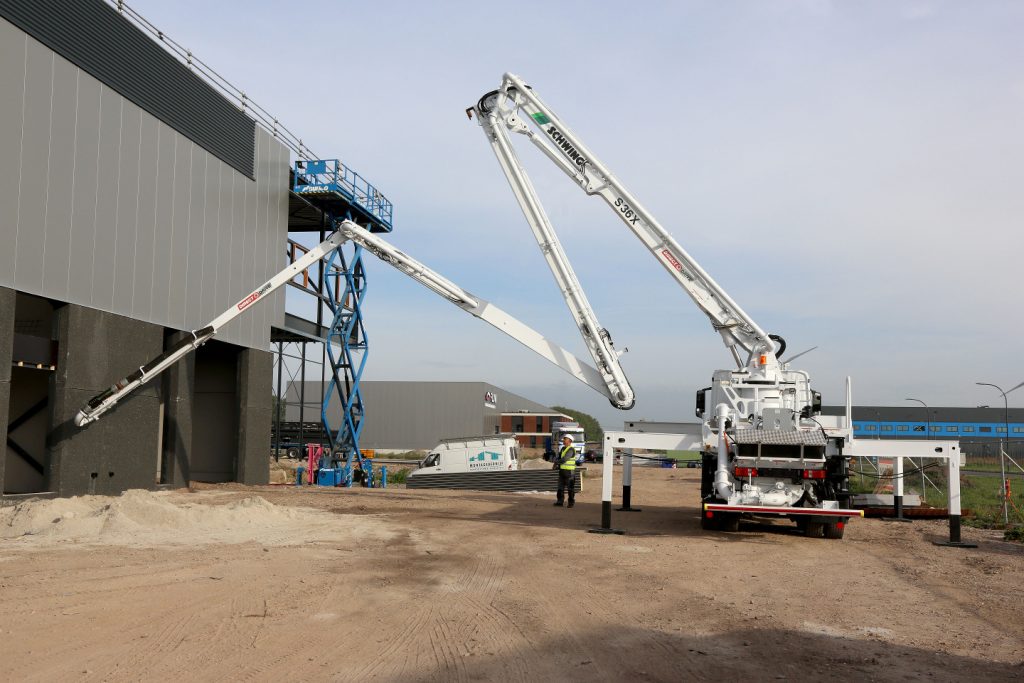
Einsatz der Betonpumpe auf einer Baustelle.
Im Stand der Technik werden die Verfahrgeschwindigkeiten von solchen Auslegersystemen stark eingeschränkt um die Sicherheit zu gewährleisten und die Aus- und Einfaltbewegung erfolgt schrittweise bei gleichzeitiger Bewegung von maximal 2-3 Gelenken. Weiterhin erfordert die Bedienung einer Betonpumpe erfahrenes Bedienpersonal. Die Entwicklungen im Off-Highway Bereich der letzten Jahre zeigen einen deutlichen Zuwachs an immer komplexer werdenden Assistenz- und Sicherheitssystemen, die das Bedienpersonal bei der Arbeit aktiv im Hinblick auf verbesserten Bedienkomfort unterstützen und eine erhöhte Sicherheit automatisierter Prozesse ermöglichen.
Projektschwerpunkte
Im Rahmen des Forschungsprojektes wurde ein System entwickelt um zeitoptimale, kollisionsfreie Bewegungen für den Ausleger der Betonpumpe zu berechnen. Die berechneten Bewegungen berücksichtigen neben den technischen Beschränkungen der Gelenkswinkel und Gelenkswinkelgeschwindigkeiten ebenfalls gesetzliche Rahmenbedingungen im Sinne maximaler kartesischer Geschwindigkeiten systematisch. Weiters wird im Falle einer nicht vollständigen Abstützung mit Hilfe der Stützbeinen (z.B. aufgrund von mangelndem Platz an der Baustelle), der Arbeitsbereich der Maschine systematisch beschränkt. Das entwickelte Konzept wurde an einer realen Maschine mit 5 unabhängigen Drehgelenken validiert.
Ausgewählte Publikationen
- J. Henikl, W. Kemmetmüller, and A. Kugi, Estimation and control of the tool center point of a mobile concrete pump, Automation in Construction, vol. 61, p. 112–123, 2016.
[BibTex] [Download]@Article{Henikl16, Title = {Estimation and control of the tool center point of a mobile concrete pump}, Author = {Henikl, J. and Kemmetm\"uller, W. and Kugi, A.}, Journal = {Automation in Construction}, Pages = {112--123}, Volume = {61}, Year = {2016}, Doi = {10.1016/j.autcon.2015.10.005}, ISSN = {0926-5805}, } - J. Henikl, W. Kemmetmüller, T. Meurer, and A. Kugi, Infinite-dimensional decentralized damping control of large-scale manipulators with hydraulic actuation, Automatica, vol. 63, p. 101–115, 2016.
[BibTex] [Download]@Article{Henikl16a, Title = {Infinite-dimensional decentralized damping control of large-scale manipulators with hydraulic actuation}, Author = {Henikl, J. and Kemmetm\"uller, W. and Meurer, T. and Kugi, A.}, Journal = {Automatica}, Pages = {101--115}, Volume = {63}, Year = {2016}, Doi = {10.1016/j.automatica.2015.10.024}, ISSN = {0005-1098}, } - J. Henikl, W. Kemmetmüller, M. Bader, and A. Kugi, Modeling, Simulation and Identification of a Mobile Concrete Pump, Mathematical and Computer Modelling of Dynamical Systems, vol. 21, iss. 2, p. 180–201, 2015.
[BibTex] [Download]@Article{Henikl14, Title = {Modeling, Simulation and Identification of a Mobile Concrete Pump}, Author = {Henikl, J. and Kemmetm\"uller, W. and Bader, M. and Kugi, A.}, Journal = {Mathematical and Computer Modelling of Dynamical Systems}, Pages = {180--201}, Volume = {21}, Year = {2015}, Number = {2}, Doi = {10.1080/13873954.2014.926277}, } - M. Meiringer, A. Kugi, and K. W., Time-optimal fold out of large-scale manipulators with obstacle avoidance, in Proceedings of the 11th IFAC Symposium on Nonlinear Control Systems NOLCOS 2019, Vienna, Austria, 2019, pp. 114-119.
[BibTex]@InProceedings{Meiringer2019, author = {Meiringer, M. and Kugi, A. and Kemmetm\"uller W.}, title = {Time-optimal fold out of large-scale manipulators with obstacle avoidance}, booktitle = {Proceedings of the 11th IFAC Symposium on Nonlinear Control Systems NOLCOS 2019}, year = {2019}, volume = {52}, number = {16}, month = {9}, pages = {114-119}, doi = {10.1016/j.ifacol.2019.11.765}, address = {Vienna, Austria}, issn = {2405-8963}, } - W. Kemmetmüller, M. Meiringer, V. Platzgummer, and A. Kugi, Optimale Abstützung eines mobilen Großraummanipulators, at – Automatisierungstechnik, vol. 69, iss. 9, p. 782–794, 2021.
[BibTex]@Article{Kemmetmueller2021, author = {Wolfgang Kemmetmüller and Martin Meiringer and Valentin Platzgummer and Andreas Kugi}, title = {Optimale Abstützung eines mobilen Großraummanipulators}, doi = {doi:10.1515/auto-2021-0052}, number = {9}, pages = {782--794}, url = {https://doi.org/10.1515/auto-2021-0052}, volume = {69}, journal = {at -- Automatisierungstechnik}, year = {2021}, } - M. Meiringer, A. Kugi, and W. Kemmetmüller, Modelling and calibration of a five link elastic boom of a mobile concrete pump, Mathematical and Computer Modelling of Dynamical Systems, vol. 29, iss. 1, p. 41–68, 2023.
[BibTex] [Download]@Article{Meiringer2023, author = {M. Meiringer and A. Kugi and W. Kemmetm\"uller}, title = {Modelling and calibration of a five link elastic boom of a mobile concrete pump}, doi = {10.1080/13873954.2023.2177311}, number = {1}, pages = {41--68}, volume = {29}, journal = {Mathematical and Computer Modelling of Dynamical Systems}, year = {2023}, } - M. Meiringer, A. Kugi, and W. Kemmetmüller, Semi-autonomous operation of a mobile concrete pump, Automation in Construction, vol. 156, p. 105079, 2023.
[BibTex]@Article{Meiringer2023a, author = {Meiringer, M. and Kugi, A. and Kemmetm\"uller, W.}, title = {Semi-autonomous operation of a mobile concrete pump}, doi = {10.1016/j.autcon.2023.105079}, pages = {105079}, volume = {156}, journal = {Automation in Construction}, year = {2023}, }
02.06.2021 High-speed large format 3D printing
Project focus
- Development of a high speed polygon mirror based SLA 3D-printer
- Opto-mechatronic system design for maximum performance
- Characterization of polygon mirrors
- Correction methods for high resolution printing
Description
Additive manufacturing (AM) constantly gains in importance in the manufacturing industry. Compared to classical manufacturing technologies, it offers many advantages such as almost unlimited design freedom, direct manufacturing of parts from CAD models and affordable manufacturing even at low quantities. Furthermore, parts can be produced with minimum excessive material consumption compared to conventional manufacturing methods. This leads to a significantly reduced ecological footprint of AM. State of the art industrial printers, which achieve high resolution and accuracy, are based on the stereolithography (SLA) principle in combination with Galvanometer beam steering, which scan a laser spot over a resin surface for photopolymerization. Scanning speeds between 2 m/s and 30 m/s are typical and limited by the scanner dynamics, such that medium and large part counts are not economically achievable. By speeding up the manufacturing processes this limitation can be circumvented, enabling additive mass production.
Approach
In order to increase the printing speed and volume without impairing the achievable resolution, an integrated opto-mechatronic system design is applied in this project. In the development of the optical scanning unit, not only conventional galvanometer scanners, but also other scanners such as fast steering mirrors and polygon scanners will be considered. Such components will be synthesized to complement each other, where their interaction will be explicitly considered. Control algorithms of the synthesized system will be selected and designed by considering the underlying physical phenomena, such as mechanical dynamics and photochemical dynamics for the highest possible performance.
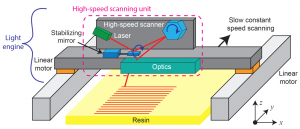 Schematic setup of the polygon mirror based SLA 3D-printer. The light engine, which consists out of a laser stabilizing mirror and the polygon scanner, is moved by two linear motors.[/caption]
Schematic setup of the polygon mirror based SLA 3D-printer. The light engine, which consists out of a laser stabilizing mirror and the polygon scanner, is moved by two linear motors.[/caption]
Videos
Project Partners
Funding
- FFG – Die Österreichische Forschungsförderungsgesellschaft
- The Austrian Federal Ministry for Digital and Economic Affairs
19.04.2021 AC-KPFM
Project goals
- Development of electrical Atomic Force Microscopy (AFM) modes
- Sensing electrical charge distributions at the nanoscale in aqueous environment
- In-vitro observations of biological cells
Description
Many fundamental processes in nature rely on the interaction between surface charges at the nanoscale, whether it is about functionalization of a materials surface to make it more durable (corrosion resistant) or the interaction of a biological cells with its environment. Surface charges play a key role in such cases, as they drive electrostatic forces which have direct impact on the behaviour of the carrier. With the ability to measure the local surface potential distribution on cells in their natural environment, one could investigate the influence of specific treatments on the systems behaviour.
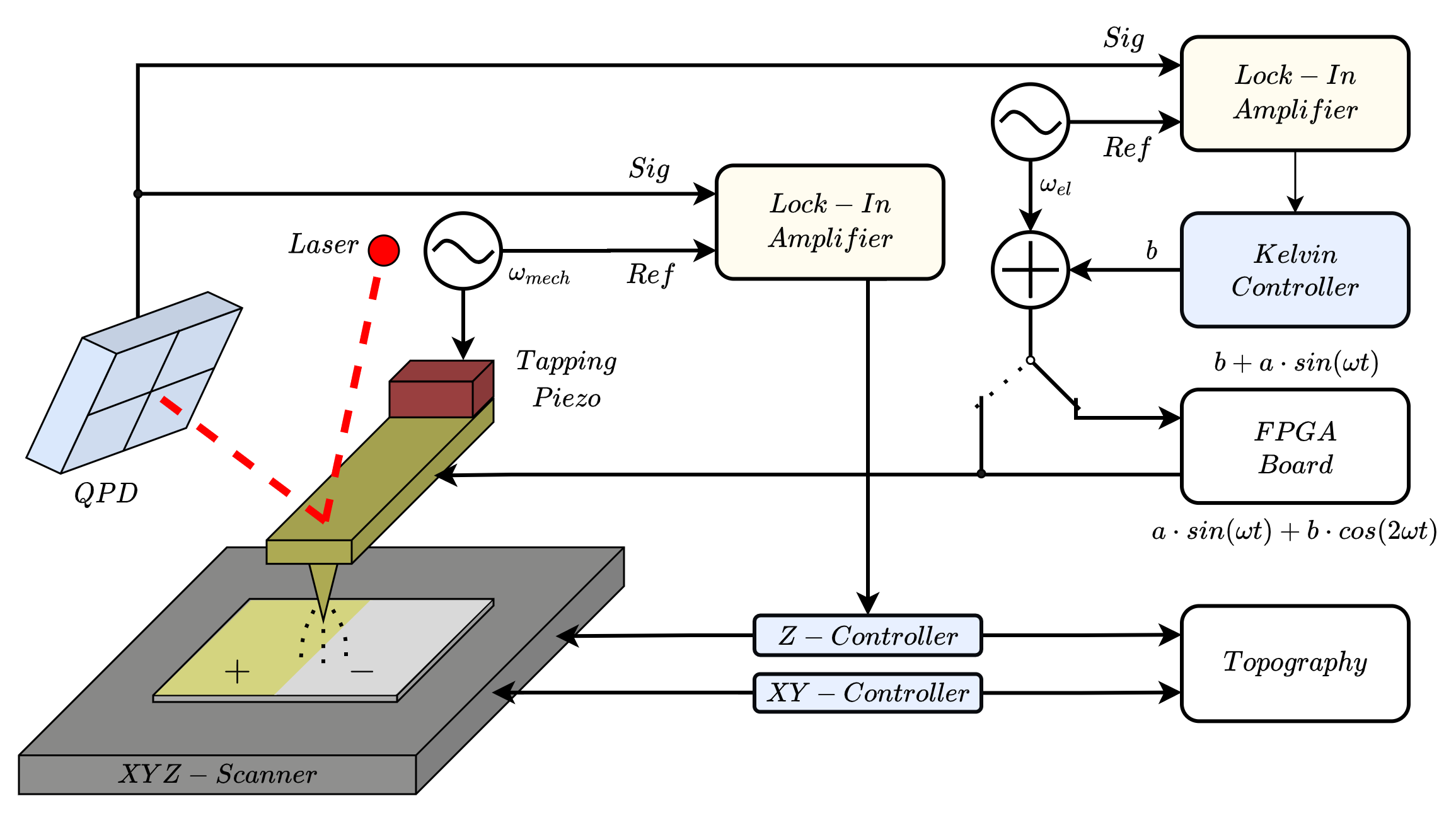
Schematic Implementation of the AC-KPFM principle in an AFM using an external FPGA board.
This project aims towards the development of electric Atomic Force Microscopy modes for quantitative charge distribution measurements in liquids, or more specific, aqueous solutions with varying ionic concentration. To this end, studies are carried out regarding the formation of electric double layers (EDLs), movement of solvated ions and influence of measurement parameters (electrical drive frequencies,…).
Use cases
- In-vitro studies of biological cells or corrosion processes
- Research applications in biological / material sciences
Related Publications
- D. Kohl, P. Mesquida, and G. Schitter, Quantitative DC-free Kelvin Probe Force Microscopy, in Final Program 42nd International Conference on Micro and Nano Engineering, 2016.
[BibTex]@InProceedings{TUW-254059, Title = {Quantitative DC-free Kelvin Probe Force Microscopy}, Author = {Kohl, Dominik and Mesquida, Patrick and Schitter, Georg}, Booktitle = {Final Program 42nd International Conference on Micro and Nano Engineering}, Year = {2016}, Note = {Vortrag: Micro and Nano Engineering 2016, VIenna; 2016-09-19 -- 2016-09-23}, Doi = {10.1016/j.mee.2017.01.005}, Numpages = {2} }
Project partner
- Physics Department, King’s College London (Dr. P. Mesquida)
Funding
- Austrian Science Fund (FWF) – Project No. P 31238-N28
19.04.2021 Atomic Force Microscopy using self-sensing cantilevers
Description
In Atomic Force Microscopy (AFM), micro-cantilevers with a sharp tip are scanned over a sample to measure various surface properties with nanometer resolution. The measurement of the cantilever deflection is a crucial part, which defines the imaging performance of AFM. Self-sensing cantilevers with integrated piezoresistive or capacitive elements enable a direct and efficient deflection measurement and are a promising alternative to the conventional optical lever method. This project aims at enabling novel AFM methods and applications by exploiting the advantages of self-sensing cantilevers.
Integrated demodulation for dynamic measurement modes
In most AFM measurement modes, the cantilever is mechanically excited at its resonance frequency and the resulting oscillation is modulated by the tip-sample interaction forces. Therefore, the demodulation of the cantilever oscillation is required to obtain sample properties. Utilizing a piezoresistive detection scheme where the deflection is converted to a change of the electrical impedance, the demodulation can be integrated in the sensor electronics, which enables a simplified measurement of the oscillation.
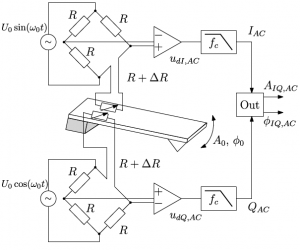
Block diagram for demodulation of self-sensing cantilever oscillation using AC-bridge circuits.
Mechatronic system design for long-range high-bandwidth AFM
The application of AFM for in-line metrology requires large vertical motion of the AFM cantilever not only for high topography measurement, but also for compensation of sample height uncertainties (e.g. thermal expansion during AFM operation). However, the actuation range and control bandwidth of the cantilever’s vertical motion are restricted in a tradeoff, influenced by the actuation type and mover mass. Using integrated self-sensing cantilevers with small mass in combination with electromagnetic actuators and an optimized flexure design, a long-rage high-bandwidth AFM is developed.
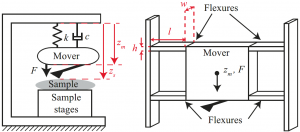
Mechatronic system design for long-range high-bandwidth cantilever motion.
Applications
- AFM for in-line metrology
- Compact and integrated AFM systems
Related Publications
- M. Poik, D. Kohl, M. Mayr, C. Kerschner, and G. Schitter, A Mechatronic Lock-In Amplifier: Integrating Demodulation in Sensor Electronics for Measuring Mechanical Oscillations, IEEE Transactions on Instrumentation and Measurement, vol. 70, pp. 1-8, 2021.
[BibTex] [Download]@article{TUW-292319, author = {Poik, Matthias and Kohl, Dominik and Mayr, Mario and Kerschner, Christoph and Schitter, Georg}, title = {A Mechatronic Lock-In Amplifier: Integrating Demodulation in Sensor Electronics for Measuring Mechanical Oscillations}, journal = {IEEE Transactions on Instrumentation and Measurement}, year = {2021}, volume = {70}, pages = {1-8}, doi = {10.1109/TIM.2020.3047208}, keywords = {Demodulation, Lock-In Amplifier, Resonant sensor, Cantilever, AFM} }
- M. Poik, D. Kohl, M. Mayr, C. Kerschner, and G. Schitter, Efficient Demodulation for Measuring the Amplitude of Mechanical Oscillations, in Proceedings of the IEEE International Instrumentation and Measurement Technology Conference (I2MTC 2020), 2020.
[BibTex] [Download]@inproceedings{TUW-291330, author = {Poik, Matthias and Kohl, Dominik and Mayr, Mario and Kerschner, Christoph and Schitter, Georg}, title = {Efficient Demodulation for Measuring the Amplitude of Mechanical Oscillations}, booktitle = {Proceedings of the IEEE International Instrumentation and Measurement Technology Conference (I2MTC 2020)}, year = {2020}, numpages = {5}, doi = {10.1109/I2MTC43012.2020.9129045}, keywords = {Demodulation, Resonant sensor, Cantilever, AFM}, note = {Vortrag: IEEE International Instrumentation and Measurement Technology Conference Proceedings I2MTC (2020), Dubrovnik, Kroatien; 2020-05-25 -- 2020-05-28} }
- S. Ito, M. Poik, J. Schlarp, and G. Schitter, Atomic Force Microscopy Breaking Through the Vertical Range-Bandwidth Tradeoff, IEEE Transactions on Industrial Electronics, 2020.
[BibTex] [Download]@article{TUW-288567, author = {Ito, Shingo and Poik, Matthias and Schlarp, Johannes and Schitter, Georg}, title = {Atomic Force Microscopy Breaking Through the Vertical Range-Bandwidth Tradeoff}, journal = {IEEE Transactions on Industrial Electronics}, year = {2020}, numpages = {9}, doi = {10.1109/TIE.2020.2982113}, keywords = {Atomic force microscopy , Mechatronics , Nanopositioning , Precision engineering , Design for control} }
19.04.2021 Sub-Mikrometer Rastersonden-basierte Charakterisierung von HF-Halbleiterprodukten auf Waferebene (SuRF)
Ziele
- Entwicklung eines rastersondenbasierten Metrologiesystems zur Submikrometer-Charakterisierung und Prüfung von RF-Halbleiterprodukten
- Präzise Tastkopfausrichtung und Automatisierung für die In-Device-HF-Messtechnik
- Bewertung der Charakterisierung von Millimeterwellen-Schaltungen auf auf Bauelement- und Wafer-Ebene
Beschreibung
HF-Systeme gehören zu den Schlüsselkomponenten moderner Technologien wie beispielsweise Radar für Umgebungserfassung zum sicheren automatisierten Fahren durch Nacht und Nebel und Internet der Dinge wie 5G-Telekommunikations-Chips. Nach dem Stand der Technik haben HF-Tastsysteme aufgrund der großen Kontaktflächen herkömmlicher Masse-Signal-Masse-Tastköpfe eine begrenzte räumliche Auflösung und können keine Signale innerhalb des aktiven Bereichs der HF-Strukturen messen.
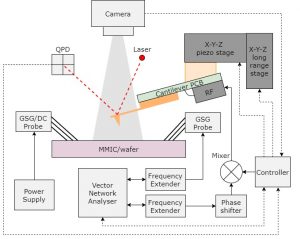
Konzept des flexiblen und versatilen HF-Mikroskopiesystems für die Charakterisierung nanoskaliger HF- und Millimeterwellenschaltungen
SuRF wird dies durch die Entwicklung eines flexiblen und versatilen HF-Mikroskopie-systems bis 90 GHz mit einer Positionsauflösung im Submikrometer-bereich unter Verwendung von leitfähigen Rasterkraftmikroskopie (AFM)-Cantilevern angehen. Fortschrittliche Steuerungs- und Positionierungsalgorithmen mit kamerabasierter und optischer AFM-Auslesung ermöglichen HF-Messungen mit automatischer Sondenausrichtung und räumlicher Auflösung im Nanometer-bereich. Das entwickelte HF-Scanning-Tastsystem wird an mmWave-Schaltkreisen und auf Wafer-Ebene verifiziert, um die Fähigkeit zur Inline-Metrologie in der Produktion zu validieren. Die einzigartigen HF-Messungen ermöglichen eine Reduktion der Designzyklen, die Verkleinerung der Chipgröße und den Entwurf innovativer HF-Produkte durch die erhöhte räumliche Präzision.
Anwendungen
- Inline-Messtechnik für die Produktion von Hochfrequenz- (RF) und Millimeterwellen- (mmWave) System-on-a-Chip Halbleiter-Schaltungen wie Radar und 5G-Telekommunikation
Projektpartner
- Infineon Technology Austria AG
Förderung
- Produktion der Zukunft, FFG – Austrian Research Promotion Agency
- Infineon Technology Austria AG
15.04.2021 RF-AFM
Goals
- Development of contactless probing system for evaluation of integrated circuits
- Measurement of voltage distribution within RF-devices
Description
The accurate measurement of local RF-voltages within integrated circuits is crucial for the development of miniaturized electronic devices. Contactless probing techniques are considered a promising approach to overcome the space limitations imposed by the size of required contact pads used in conventional probing techniques. This project aims at developing a scanning probe based measurement system capable of mapping voltages within RF-devices with sub-um spatial resolution.
Scanning probe based microscopy systems are widely used for surface analysis in various research fields, such as biology, physics and material science. A small probe is scanned over the investigated sample to record surface properties with nanometer resolution. Due to its outstanding spatial resolution, this concept is employed for the measurement of voltages in highly integrated RF-devices in this project.
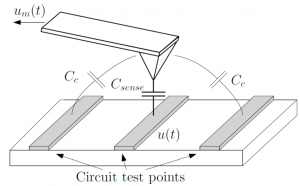
Capacitively coupled micro-cantilever used to measure local voltages on chip surface.
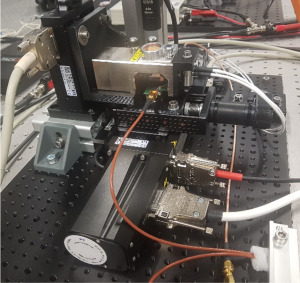
Image of experimental setup for automated contactless probing.
A small conducting probe is used as capacitively coupled sensor which is moved to individual circuit test points using high precision positioning stages. The measurement system can therefore be used for contactless evaluation of circuits without modifications of the layout. The small physical size of today’s RF-devices impose major challenges on the development of the system which have to be solved and will be addressed in this project.
To this end, a detailed analysis of the probe-circuit interaction is carried out using electrostatic and circuit simulations to identify the relevant trade-offs between sensitivity, spatial resolution and invasiveness, thus enabling the selection of suitable measurement parameters for achieving the best possible performance.
Applications
- Development and verification of RF-devices
- Failure analysis
Project Partners
08.03.2021 Digital Literacy in Robotics & Informatics – for underprivileged people
Robotik und Informatik sind ohne digitale Kompetenz nicht denkbar. Beide sind ein möglicher Einstieg in die digitale Welt und fördern die Entwicklung der digitalen Kompetenz. Es stellt sich aber auch die Frage, welche Barrieren im digitalen Raum entstehen und wie diese überwunden werden können. Dazu wird eine Arbeitsgruppe mit interdisziplinären Mitgliedern aus unterschiedlichen Partneruniversitäten gegründet, die gemeinsame Barrieren sichtbar machen und Verbesserungen für gendergerechte didaktische Konzepte und Produktentwicklung vorschlagen.
Partners:
TU Wien ACIN Institut für Automatisierungs- und Regelungstechnik
TU Wien Department of Geodesy Geoinformation
FH Technikum Wien Digital Manufacturing & Robotics
FH Technikum Wien Informatik
Universität Wien, Institut für Bildungswissenschaften
Funding:
Dieses Projekt wird von CTS der TU Wien mit der Projektnummer GEV376020CTS finanziert.
19.02.2021 Versatile technology platform for MEMS scan system for automotive safety applications (AUTOScan)
Project focus
- Versatile technology for automotive MEMS mirror
- Sensing and Actuation for high performance MEMS scan systems
- Advanced control development for automotive qualified MEMS scan systems
- Feasibility evaluation of the MEMS scan system for automotive safety applications.
Description
Advancements of sensors, communication and artificial intelligence are about to bring a revolutionary changes in mobility and transportation by autonomous driving. Scanning mirrors based on Micro-Electro-Mechanical Systems (MEMS) technologies are one of the promising solutions for various automotive applications, e.g. photonic sensing such as lidars and human machine interfaces such as augmented reality head -up display (AR HUD) and smart headlights. Small form factor, high scanning performance and scalable low unit cost by mass production are raised as main advantages of the MEMS scanning solution for automotive applications. As a drawback, MEMS mirrors are prone to harsh operating conditions such as vibrations, shocks, and temperature variations, requiring highly robust system design with controls to guarantee their full device performance at any situation. However, it is challenging for analysis and control design since MEMS mirrors are highly nonlinear devices.
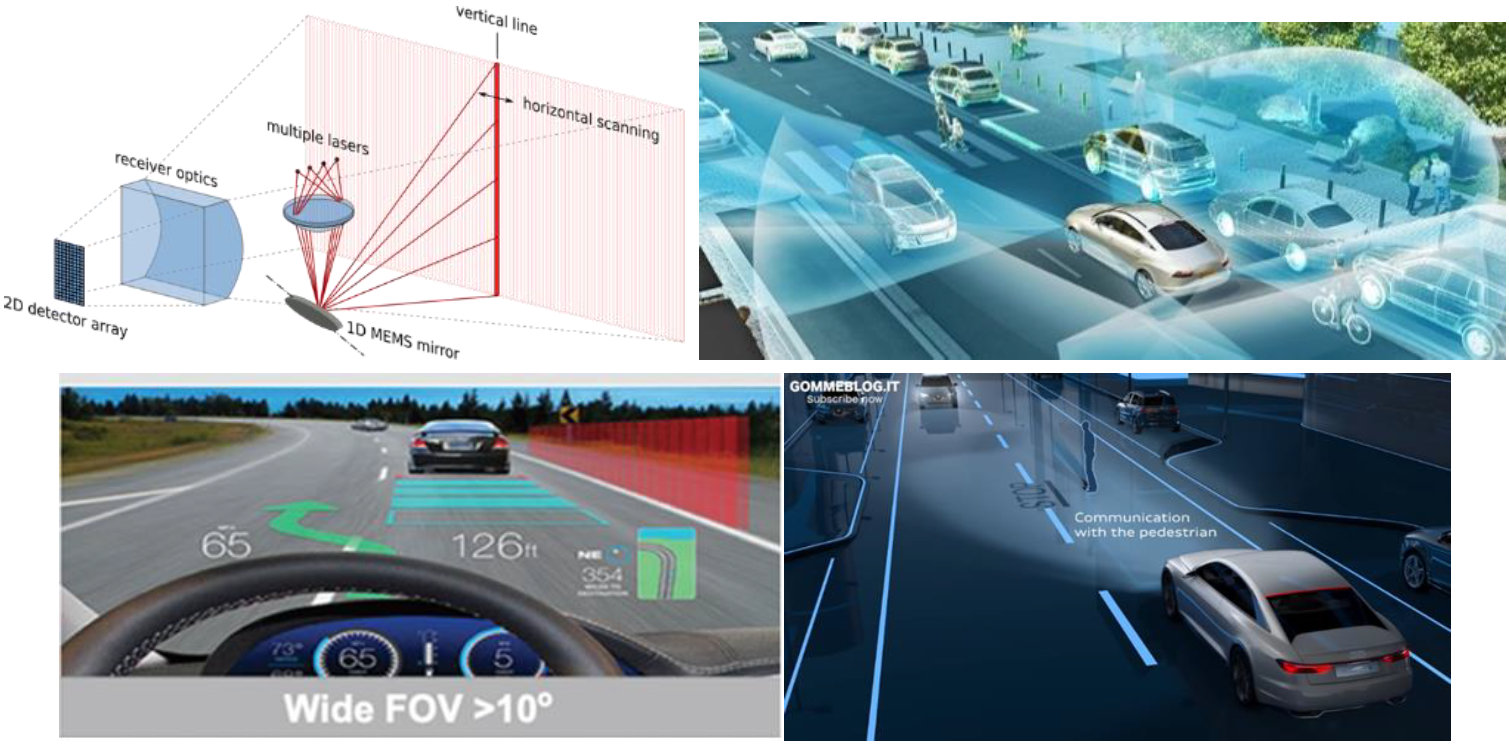
Concepts of (top left) 1D MEMS scanning lidar [Yoo et al, E & I, 135, 6, 2018], (top right) lidars and other sensors for surroundings [Hecht, Optics Photonics News, 29, 1, 2018], (bottom left) AR head up display [Ballard et al, SID DTP, 2016], and (bottom right) smart headlights [Audi OLED | Audi Future LAB, 2015, link
Applications
- Lidar for autonomous driving
- Augmented reality head up display
- Precision measurement systems
Related Publications and Patents
Journal articles
- R. Schroedter, H. W. Yoo, D. Brunner, and G. Schitter, Charge-Based Capacitive Self-Sensing With Continuous State Observation for Resonant Electrostatic MEMS Mirrors, Journal Of Microelectromechanical Systems, vol. 30, iss. 6, p. 897–906, 2021.
[BibTex] [Download]@article{TUW-299022, author = {Schroedter, Richard and Yoo, Han Woong and Brunner, David and Schitter, Georg}, title = {Charge-Based Capacitive Self-Sensing With Continuous State Observation for Resonant Electrostatic MEMS Mirrors}, journal = {Journal Of Microelectromechanical Systems}, year = {2021}, volume = {30}, number = {6}, pages = {897--906}, doi = {10.1109/JMEMS.2021.3107797}, keywords = {Charge-based capacitive self-sensing , resonant MEMS mirror , electrostatic comb drive , switched current integrator , capacitance network , nonlinear switched input Luenberger observer} }
- D. Brunner, H. W. Yoo, R. Schroedter, and G. Schitter, Adaptive Lissajous scanning pattern design by phase modulation, Optics Express, vol. 29, iss. 18, p. 27989–28004, 2021.
[BibTex] [Download]@article{TUW-296868, author = {Brunner, David and Yoo, Han Woong and Schroedter, Richard and Schitter, Georg}, title = {Adaptive Lissajous scanning pattern design by phase modulation}, journal = {Optics Express}, year = {2021}, volume = {29}, number = {18}, pages = {27989--28004}, doi = {10.1364/OE.430171} }
- H. W. Yoo, D. Brunner, M. Macho, L. Niedermueller, A. J. Devesa, L. Kormann, and G. Schitter, Evaluation of robustness against external vibrations for long-range MEMS lidar with one-dimensional resonant micromirror, Journal of Optical Microsystems, vol. 2, iss. 1, 2022.
[BibTex] [Download]@article{TUW-303700, author = {Yoo, Han Woong and Brunner, David and Macho, Matthias and Niedermueller, Leonhard and Devesa, Angel Jurado and Kormann, Leonhard and Schitter, Georg}, title = {Evaluation of robustness against external vibrations for long-range MEMS lidar with one-dimensional resonant micromirror}, journal = {Journal of Optical Microsystems}, year = {2022}, volume = {2}, number = {1}, doi = {10.1117/1.JOM.2.1.011007}, keywords = {Microelectromechanical systems, LIDAR, Mirrors, Clouds, Receivers, Transmitters, Field programmable gate arrays, Optical microsystems, Video, Microcontrollers} }
News
Project partners
Funding
- FFG Mobilität der Zukunft
This project (activity) has received funding from the Mobility of the Future programme. Mobility of the Future is a research, technology and innovation funding programme of the Republic of Austria, Ministry of Climate Action. The Austrian Research Promotion Agency (FFG) has been authorised for the programme management
17.11.2020 PriMActO
Ziele
- Entwicklung einer systematischen Vorgehensweise zum strukturierten Entwurf der Lagerung.
- Entwicklung eines modularen Ansatzes zur Lagerung des Primärspiegels mittels aktiver Optik für den Bau von Leichtgewichtteleskopen.
- Aufbau einer Primärspiegelzelle der 1-m-Klasse mit aktiver axialer und lateraler Lagerung sowie die Integration der Spiegelzelle in ein Teleskopsystem des Projektpartners.
Beschreibung
Teleskope mittlerer Größe mit Durchmessern zwischen 0,6 m und 2,0 m sind aktuell von zunehmender Bedeutung in etablierten wie auch derzeit neu entstehenden Anwendungsgebieten. Optische Kommunikation mit Satelliten im Erdorbit, mit welcher mehr als zehnfach höhere Datenraten möglich sind als mit aktueller Funkübertragung, sowie das Erfassen und Verfolgen der Trajektorien von Weltraumschrott bzw. Space Debris, um das Risiko für funktionelle Satelliten zu minimieren, sind zwei Beispiele für Anwendungsgebiete, für deren gute Funktionalität robuste Teleskope mittlere Größe mit hohem Lichtsammelvermögen eine Grundvoraussetzung sind. Um eine entsprechende Zuverlässigkeit dieser Systeme zu garantieren, ist eine große Anzahl an Bodenstationen erforderlich, die ein geringes Gewicht der Teleskope zum leichten Transport und zur einfache Montage, sowie geringe Produktionskosten wünschenswert macht.
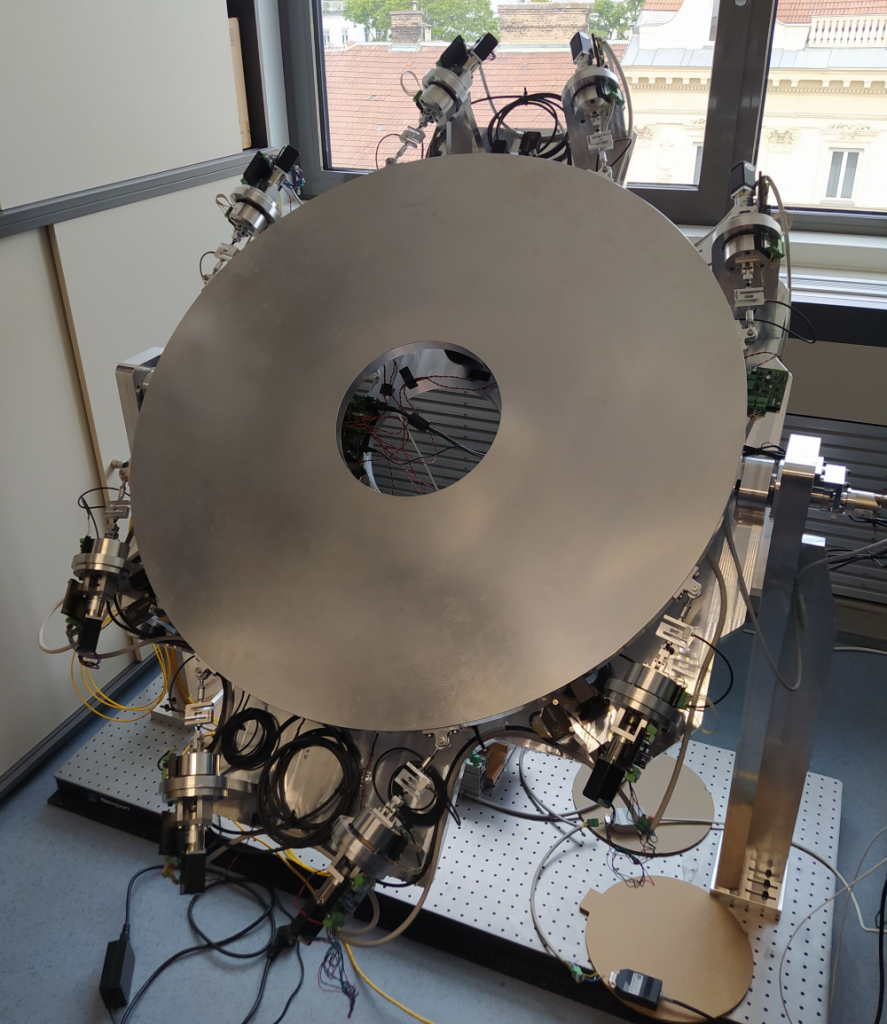
Laborsetup der Primärspiegelzelle mit Aluminiumspiegel.
Um das Gewicht und die Kosten für Produktion, Transport und Montage aktueller, vergleichsweise schwerer, Teleskope in der 1-m-Klasse mit Massen im Bereich von 1500 kg zu reduzieren, können dünne Leichtspiegel eingesetzt werden um das Gewicht des Primärspiegels – der maßgebende Faktor für Produktionskosten und Gesamtgewicht – zu verringern. Damit die gravitationsbedingte Verformung dünner Spiegel nicht die Abbildungsqualität des Leichtbauteleskops beeinträchtigt, ist es das Ziel des vorliegenden Projekts, Methoden für die Entwicklung und die Integration einer aktiven Optik in die Primärspiegelzelle von Teleskopen des Industriepartners, ASA Astrosysteme GmbH, in der 1-m-Klasse zu entwickeln. Die aktive Optik ermöglicht mittels aktiver axialer und lateraler Lagerung eine Formkorrektur des Primärspiegels, um lage- und temperaturabhängige Verformungen zu kompensieren. Durch ein integriertes mechatronisches Systemdesign soll dabei eine extrem leichte Bauweise, eine hohe Abbildungsqualität des Systems und eine kosteneffiziente Lösung erreicht werden. Im Zuge dessen werden ein modulares Konzept für das Systemdesign inklusive Methoden zur optimalen Anzahl und Platzierung der Aktuatoren über die Spiegelfläche, sowie modulare und integrierte mechatronische Aktuator-Sensor-Systeme entwickelt. Mittels optimaler Systemintegration werden dabei das Zusammenspiel der Systemkomponenten, der Systemanforderungen und des Echtzeitregelungssystems systematisch berücksichtigt und leichte Teleskope höchster optischer Qualität ermöglicht.
Anwendungen
- Satellitenkommunikation
- Space Debris Observation
Relevante Publikationen
- C. Schwaer, A. Sinn, P. Keller, and G. Schitter, Design methodology to develop an active optics system for a thin 1-m meniscus mirror, Journal of Astronomical Telescopes, Instruments, and Systems, vol. 6, iss. 4, p. 049002-1–049002-22, 2020.
[BibTex] [Download]@article{TUW-291787, author = {Schwaer, Christian and Sinn, Andreas and Keller, Philipp and Schitter, Georg}, title = {Design methodology to develop an active optics system for a thin 1-m meniscus mirror}, journal = {Journal of Astronomical Telescopes, Instruments, and Systems}, year = {2020}, volume = {6}, number = {4}, pages = {049002-1--049002-22}, doi = {10.1117/1.JATIS.6.4.049002}, keywords = {active optics, telescopes, mirrors, lightweight design, finite element analysis, mechatronic system design} }
- C. Schwaer, A. Sinn, and G. Schitter, Mechatronic Approach towards Lightweight Mirrors with Active Optics for Telescope Systems, in Proceedings of the Joint Conference 8th IFAC Symposium on Mechatronic Systems (MECHATRONICS 2019), and 11th IFAC Symposium on Nonlinear Control Systems (NOLCOS 2019), 2019.
[BibTex] [Download]@InProceedings{TUW-281662, author = {Schwaer, Christian and Sinn, Andreas and Schitter, Georg}, title = {Mechatronic Approach towards Lightweight Mirrors with Active Optics for Telescope Systems}, booktitle = {Proceedings of the Joint Conference 8th IFAC Symposium on Mechatronic Systems (MECHATRONICS 2019), and 11th IFAC Symposium on Nonlinear Control Systems (NOLCOS 2019)}, year = {2019}, volume = {52/15}, note = {Vortrag: Joint Conference 8th IFAC Symposium on Mechatronic Systems (MECHATRONICS 2019), and 11th IFAC Symposium on Nonlinear Control Systems (NOLCOS 2019), Wien; 2019-09-04 -- 2019-09-06}, doi = {10.1016/j.ifacol.2019.11.641}, journal = {IFAC-PapersOnLine/Elsevier}, keywords = {Active Optics, Meniscus Mirror, System Analysis, Optomechatronics}, numpages = {6}, }
